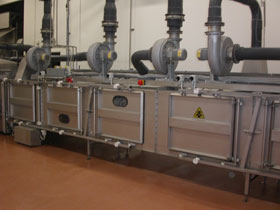

Vision
Vision gives the animal valuable, detailed information about the surroundings, i.e. various types of threats or the whereabouts of the herd.
Light from different objects in the surroundings is focused by the lens on the retina which transmits nerve signals to the brain where the image is interpreted.
Drawing: Anne Larsen, SLU.
Even if there are some differences among the production animals, the eyes still have similar build and function. Incoming light from the surroundings reach sensory cells on the retina, which transmits information to the brain, where the image is interpreted.
|
Produktionsdjur förutom mink har en bra översikt (gult), har djupseende och kan bedöma avstånd i ett begränsat område framåt (blått) och ser ingenting alls i ett begränsat område bakåt när huvudet hålls rakt fram (grått). Illustration: Sofia Wiberg, SLU. |
The wild ancestors to our production animals constantly had to to keep watch for predators, a behaviour that remains with the production animals today. They are, minks excluded, prey and react quickly to danger, i.e. sudden movements, by fleeing. Vision is very important for the animal to be able to detect a predator in time. This is reflected in how the eyes placed. The eyes are placed laterally on the head, usually between 300 to 330° (the human field of vision is 180°). The extensive panorama viewing depends on the animal being able to notice different views with each eye. The animals have stereopsis and can estimate distances in a limited area straight forward where the fields of vision are overlapping. There iscan angle backward, a blind zone, where the animal does not see anything when the head is hold straight forward.
You can read more about the importance of vision for slaughter and killing in the module Handling.
Equine and bovine animals
Equine and bovine animals have limited ability to alternate between short distance and long distance vision. They have to look straight at an object to see it clearly and to be able to make distance estimates. These limitations may explain why the animals hesitate or avoid foreign elements in their way.
The animals must lower their heads to clearly see objects on the ground directly in front of them. This makes it more complicated for the animals to walk down i.e. a ramp. It takes a while for the eye to adjust so that the the animal can see clearly at a close distance.
Equine and bovine animals experience light contrasts and some colour vision. They have a fairly good vision in the dark.
[QTL-Question id=145]

Estimating distances
Study objects in the room at different distances, first with both eyes open and thereafter with only one eye open. Do you notice any difference?
|
Cattle see movements better than standing objects. It is easier for them to see an animal that is moving hundreds of metres away than an object, i.e. a branch or other protruding object, at close range. Cattle are considered to have difficulties to focus and estimate distances, which would explain why they, often without evading, can rush straight against a wire or chain while evading a more visible fence. This can also explain why they evade shadows as if they were physical obstacles. |


Pigs do not have well developed vision. They have limited vison at long range. Pigs do probably detect moving objects easier than standing.
Photo: Guiseppe Vezzoli.


Horses raise their head to be able to see distant objects clearly, and lower it to see close objects clearly. Horses can detect very subtle changes when an object is focused, i.e. movements in the face and the position of the ears of another horse. Except for the blind zone backward, horses do not see an area just in front of the muzzle. Therefore, the horse does not see what it is eating while feeding, and may not detect a hand that is lead to the muzzle or the mouth. Horses have good vision in the dark. Photo: Kristina Johansson.


Sheep are regarded to have good vision both at close and distant range. They see movements better than standing objects. Sheep are regarded to have difficulties to focus and estimate distances, which would explain why they, often without evading, can rush straight against a wire or chain while evading a more visible fence. This can also explain why they evade shadows as if they were physical obstacles. Vision can be limited the amount of wool and the horns and the ears. An animal with a limited field of vision is more easily scared. Photo: Jan Svedberg.


